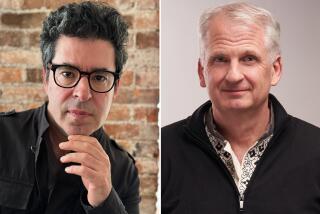Postscript to a Stormy Chapter in Hollywood
John Sanford is an authentic hero of American letters. His more than 20 books, though still too infrequently appreciated, are among its treasures.
More remarkable yet, the Santa Barbara-based writer, who is now in his 99th year, still is adding to a body of work whose formal bravura and lyric prose are nearly without parallel in contemporary literature.
His latest book, “A Palace of Silver,” will be published in March by Capra Press. Like so much of his later work, it defies generic boundaries. It is at once a memoir and a meditation on his 50 years of marriage to screenwriter Marguerite Roberts, who died a decade ago.
Its title is drawn from a verse in the Song of Solomon: “We will build upon her a palace of silver.” The Sanfords’ marriage, in fact, was a kind of palace built upon what might have been the ruins of careers cut short by the Hollywood blacklist.
Sanford was already a Communist Party member when he and his friend Nathanael West arrived in Hollywood in the 1930s. Sanford also was a critically acclaimed novelist, whose first book--”A Man Without Shoes”--had been published in 1933 with a blurb from Carl Sandburg.
In Hollywood, Sanford met and married Roberts, then one of the industry’s most successful contract screenwriters. She became the emotional, aesthetic and financial supporter of his work.
Partly out of solidarity, partly to smooth their social life together, Roberts became a Communist, too. Neither adhered very closely to the party line.
When Sanford’s now classic anti-racist novel, “The People From Heaven”--recently reissued by the University of Illinois Press as part of its series, “The Radical Novel Reconsidered”--was published in 1943, William Carlos Williams and Orson Welles praised it; the party denounced it as “antisocial.”
Ultimately, the couple were subpoenaed to appear before the House Un-American Activities Committee.
They refused to name names. She lost her job and was blacklisted. Both their passports were seized, foreclosing the possibility of work abroad. It would be 10 years before she worked again. That fraught interregnum--its mutual support, its separate suffering and Sanford’s torment over the calamity into which he had drawn her--is the central room in “A Palace of Silver.”
“Most of the stuff I’ve written in the past 15 years is about my wife,” Sanford said this week. “She is more than my muse; she is my subject. Those were tremendously difficult times for my wife.
“She was at the height of her career as a screenwriter at Metro. Then along came the committee. We were Communists. The informants told the truth about that, at least,” he said. “We were called and refused to name names. The studio terminated her contract that day.
“She joined the party for me,” Sanford said, “and, unfortunately, I didn’t make any attempt to stop her. She wasn’t a revolutionary. She was a nice, liberal lady, who believed in decency and reform. It cost her dearly and my punishment was second only to hers. She suffered greatly and spoke not one word of recrimination to me in those 10 years.
“She used to say, ‘Don’t blame yourself, Johnny,’ and she meant it. But that didn’t spare me from the feelings I’ve set down in that book.”
Aesthetic and political radicalism notwithstanding, there is a sturdy, old-fashioned virtue at the heart of Sanford’s project: It is sincerity--a sincerity so serious and complete that it stands as a kind of reproach to the current vogue for confessional memoirs.
That was one of the qualities that attracted Capra’s new owner, bookseller Robert Bason. He offered Sanford the revived press’ first contract after purchasing Capra from the family of its late founder, Noel Young, in November. “A Palace of Silver” is one of the first three books Capra will bring out in March.
“I think it is an absolutely wonderful work,” said Richard Barre, Capra’s associate publisher. “John is so rare and open. It’s as if his marriage was a room in which he lived. Parts of it were untidy, parts were pretty spiffed up, but he welcomes you into it all. It’s as if he’s saying, ‘Here’s who I am and welcome to it.’ The amazing thing is that there is nothing self-serving in any of it. He takes his work immensely seriously, but not himself.”
Capra, Barre said, also is looking forward to publishing the book on which Sanford even now is at work. “John is a world unto himself,” he said. “He just keeps writing and writing. It doesn’t matter what time of the day or night you talk to him, he’s working. From what he’s told me, this new book is about three people he used to know and the blacklist,” Barre said.
“I’m writing about it at this very moment,” Sanford said. Though his eyes are failing, the new book--like all his others--is being written on a battered old Royal typewriter.
“Nowadays,” he chuckled, “I’m a bit of an old Royal, myself.”
Work in Progress
Debora Silverman, who holds the President’s Chair in Modern European History, Art and Culture at UCLA, is the author of numerous works of art history, most recently, “Van Gogh and Gauguin: The Search for Sacred Art”:
“Actually, I am starting a new project on the Belgian avant-garde in the 1880s and 1890s. I am interested in the way it mixed urban change, socialist politics and Symbolism as an artistic movement.
“In the rest of Europe, Symbolism was aesthetic, mystical and anti-modern, rejecting politics. But in the Belgian case, artists were not in flight from politics, but deeply engaged. My thesis is that Belgium in the 1880s was like France in the 1830s, a time when the arts there were completely politicized by Romanticism--a movement that, in the rest of Europe, was associated with the rejection of politics.
“In Belgium during the 1880s and ‘90s, all the radical artists were socialists struggling for universal suffrage. Everyone in the entire bourgeois elite became radicalized, creating a complex mix of art, politics and social change. It’s very rich stuff. What you had was an urban elite trying to carve out a new national Belgian identity and politics through art and culture. The result was a unique hothouse of cultural innovation.”
More to Read
Sign up for our Book Club newsletter
Get the latest news, events and more from the Los Angeles Times Book Club, and help us get L.A. reading and talking.
You may occasionally receive promotional content from the Los Angeles Times.






